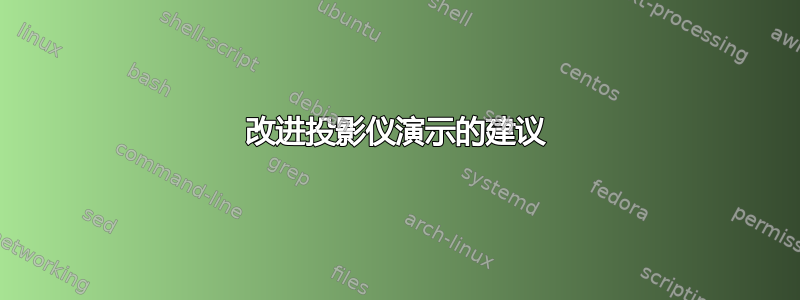
我是准备投影仪演示文稿的新手。我不知道其中有哪些高级选项可以使其更具吸引力和更合理。这是我的投影仪演示文稿代码。我需要有关如何进一步改进它的建议:
\documentclass[12pt,xcolor=dvipsnames]{beamer}
\usetheme{CambridgeUS}
\useinnertheme{rectangles}
\useoutertheme{infolines}
\setbeamercolor{frametitle}{fg=Brown,bg=Brown!20}
\setbeamercolor{section in head/foot}{bg=Brown}
\setbeamercolor{author in head/foot}{bg=Brown}
\setbeamercolor{date in head/foot}{fg=Brown}
\usepackage{tcolorbox}
\title[Semantic Web ranking]{Ranking of Web Documents using Semantic Similarity}
\author{Subham Soni}
%\date{19.8.2014}
\date{\parbox{\linewidth}{\centering%
\today\endgraf\bigskip
Submitted to\\
Dr. (Mrs.) K. Saruladha\\ B.Tech., M.Tech., Ph.D.\endgraf\medskip
Dept.\ of Computer Science and Engineering \endgraf
Pondicherry Engineering College}}
\begin{document}
\maketitle
\begin{frame}{Agenda}
\tableofcontents
\end{frame}
\section{Abstract}
\begin{frame}{Abstract}
\begin{itemize}
\item To relate documents that have similar meaning, semantic similarity approach is used by matching the keywords which are extracted
\item Here, all the relevant relations between the keywords describing user's context and then calculating the fraction of these relations on each web page to determine their relevance to user's query
\end{itemize}
\begin{tcolorbox}
\textbf{Proposal:} A Ranking algorithm for the \textit{semantic web \mbox{documents}} by finding the semantic similarity between the \mbox{documents} and the user's query
\end{tcolorbox}
\end{frame}
\section{Introduction}
\begin{frame}{Introduction}
\begin{itemize}
\item A huge of information is stored in the WWW in the form of \emph{interlinked} web pages
\item Traditional Search Engines use \textit{lexical matching} and \textit{link analysis} to produce the results
\item To overcome the limitation of lexical matching, it is necessary to determine the \textbf{relationship} between the keywords
\item Other methods such as Ontology based matching, Semantic Analysis, etc. exist but here a novel ranking model is explored which provides the result-set according the user query and semantics of the document
\end{itemize}
\end{frame}
\section{Related Work}
\begin{frame}{Related Work}
\begin{itemize}
\item Existing Ranking models:
\begin{itemize}
\item Boolean Model
\item Statistical Model
\item Hyperlink Based Model
\item Conceptual Model
\item Ontology based similarity
\end{itemize}
\end{itemize}
\end{frame}
\section{Proposed Ranking Model for Semantic Web Documents}
\begin{frame}{Proposed Ranking Model for Semantic Web Documents}
\begin{center}
\includegraphics[scale=0.33]{architecturenew}
\end{center}
\end{frame}
\begin{frame}
\begin{enumerate}
\item Determine the keywords of the document using syntactic analysis to make vector space model of the documents
\begin{enumerate}
\item A domain specific dictionary is prepared
\item The words in the dictionary are assigned weights based on their relevance to the domain using \emph{fuzzy set approach}
\item Then, the mapping of each of the words in the vector space model stored in the document repository is done with the domain specific dictionary
\end{enumerate}
\item The document similarity w.r.t the user query is also
found by extracting the concepts and the relationship that
exists between the concepts present in a document and the
mapping of the same is then done by the ontology processor
\item Finally the maximum value gives the overall relevance of the document with respect to the query
\end{enumerate}
\end{frame}
\section{Example}
\begin{frame}{Example}
\begin{itemize}
\item Consider four documents w.r.t education domain
\item The dictionary based weights are as shown:
\end{itemize}
\begin{center}
\includegraphics[scale=0.5]{dictionary}\end{center}
\end{frame}
\begin{frame}
\begin{itemize}
\item The ontology based weights are as shown:
\end{itemize}
\begin{center}
\includegraphics[scale=0.5]{ontology}\end{center}
\end{frame}
\begin{frame}
\begin{itemize}
\item The documents considered are :
\item[D1:]Education is a lifelong process. A person learns through
his experience. It goes on forever from his birth to death
without any break or barrier.
\item[D2:]Education of man does not begin at school but begins at
birth. It ends not when he graduates from university but ends
at his death. Hence, Education is a lifelong process.
\item[D3:]Education is not only academics but social also. It is
important in one's person life.
\item[D4:] In a person life everyone needs to be educated and social.
Everyone learns through experiences gained in one's life.
\end{itemize}
\end{frame}
\begin{frame}
Results:
\begin{center}
\includegraphics[scale=0.7]{results}
\end{center}
\end{frame}
\section{Future Work}
\begin{frame}{Future Work}
\begin{itemize}
\item To design more meaningful and exhaustive ranking strategy by using the semantic analysis of web pages and by deeply statistical analysis relevance of documents
\item To make the approach scalable to the semantic web
\end{itemize}
\end{frame}
\end{document}
我使用的图像如下:
architecturenew.png

dictionary.png

ontology.png

results.png

这些表格可以用 TeX 准备,但由于时间不够,我不得不从文档中复制并粘贴。
答案1
“使其更具吸引力、更合理”是一项非常主观的任务。
我当然更喜欢其他主题而不是CambridgeUS这些颜色,但我不知道哪个主题和颜色适合您。无需反复试验,您可以在 Beamer 主题矩阵页面或Beamer 主题画廊。有关一些自定义主题,请参阅 哪里可以找到自定义 Beamer 主题和ShareLaTeX 模板或者Bala 的网站。
beamer当然,您也可以从本网站的问题(参见标签)和文档(运行texdoc beamer)中获取很多想法。
不要使用\date{}在标题框中打印地址或任何长文本。请注意,在导航图标上其余框的右下角也会打印部分内容!
避免此问题的一个肮脏技巧是使用\date[]{interminable bla bla bla bla...},但对于日期的其他内容,请使用其他命令,如\subtitle{},或。例如,通过以下方式更改您的非常长的 \institute{}内容:\titlegraphic{}\logo{}\date
\date{\today}
\titlegraphic{Submitted to\\
Dr. (Mrs.) K. Saruladha\\ B.Tech., M.Tech., Ph.D.}
\institute[Pondicherry College]{
Dept. of Computer Science and Engineering \\
Pondicherry Engineering College}
\logo{\includegraphics[width=.5cm]{pecemblem.png}}
请注意,与 类似,您可以在 和 中使用\title可选参数 ( [...])来控制底部栏中显示的内容。顺便说一句,第一张幻灯片中的顶部和底部栏毫无意义,因为 已经显示了所有信息。因此,请尝试使用 而不是 \maketitle 。此外,不会造成伤害,但 是多余的。\author\institute\maketitle\frame{\titlepage \thispagestyle{empty}}\useoutertheme{infolines}\usetheme{CambridgeUS}
但毫无疑问,一个重大的改进(无论是否使用 LaTeX)将是删除表格中的所有垂直规则(仅使用 3 条水平规则)。或者可以使用柔和的行颜色代替水平规则(但我认为行颜色更适合突出显示某些数据)。提示:使用 LaTeX 和包booktabs来使用命令而\toprule不是\hline。值得花时间。对于彩色行,您可以使用包colortbl。
另一个主要问题:文字太多。请记住:人们必须听懂你的论文,但他们太忙于阅读小文字而无法注意。文本不应该是你整个演讲的平行版本,当然,不要读文本!(如果你不想让每个人都感到无聊)。
如果您确实需要包含带有长文本的长列表,那么智能地使用叠加、警报、框和幻灯片的奇特过渡可以帮助阻止读者,以便他们有时能够注意您,但请注意,即使这些效果可能会分散注意力而不是有所帮助。
说到干扰:你真的需要导航栏吗?试试 \beamertemplatenavigationsymbolsempty。甚至,试试极简主义主题,例如基调
总而言之,我认为不应该这样...

...正确使用前导命令必须至少确保幻灯片编号和日期显示正确(当然,徽标不是“Dep”):

但是在“技术上正确”的背后,我认为最好将代码的前四行改为......
\documentclass[12pt,xcolor=dvipsnames,xcolor=table]{beamer}
% \usetheme{CambridgeUS}
\useinnertheme{rectangles}
% \useoutertheme{infolines}
\beamertemplatenavigationsymbolsempty
...并将这些包添加到序言中...
\usepackage{booktabs,colortbl}
...这样您就可以在两张更清晰的幻灯片中显示该表格:
\def\grco{} do nothing in first slide
\only<2>{\def\grco{\rowcolor{green!40}}} % \grco put green color in second slide
\begin{table}
\caption{Dictionary based weights of four documents.}
\small
\begin{tabular}{clcc}
\toprule
S No. &
\parbox{.2\linewidth}{\centering Domain (Education)} &
\parbox{.2\linewidth}{Weight assigned} &
Synonyms \\
\midrule
1 & Process & .8 & $\cdots, \cdots, \cdots $\\
2 & Study & 1 & $\cdots, \cdots, \cdots $\\%
\grco 3 & Learning & 1 & $\cdots, \cdots, \cdots $\\
....
....
10 & University & .6 & $\cdots, \cdots, \cdots $\\
\bottomrule
\end{tabular}
\end{table}
...第一个是漂亮但原始的 LaTeX 表格(没有附加文本:您的工作是否解释了它是如何获得的......),第二个突出显示了最重要的数据(同时您强调它们的重要性):


记住:人们必须关注你的论文,而不是你演讲中的烟火表演。图片有帮助。短句和关键词有帮助。幻灯片的编号可能会有帮助。一篇小文章没有帮助。你不应该阅读/解释他们已经看到的内容。他们所看到的内容应该解释你所说的内容。


